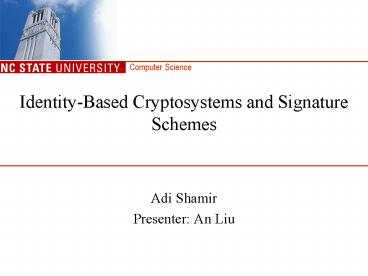IdentityBased Cryptosystems and Signature Schemes - PowerPoint PPT Presentation
1 / 10
Title:
IdentityBased Cryptosystems and Signature Schemes
Description:
Give each user a smart card when user first joins the network. Each user uses the secrete key in smart card for decryption and signature verification. ... – PowerPoint PPT presentation
Number of Views:118
Avg rating:3.0/5.0
Title: IdentityBased Cryptosystems and Signature Schemes
1
Identity-Based Cryptosystems and Signature Schemes
- Adi Shamir
- Presenter An Liu
2
Adi Shamir (from Wikipedia)
- Education
- BS, Mathematics, Tel Aviv University (1973)
- MSc, Computer Science, Weizmann Institute (1975)
- PhD, Computer Science, Weizmann Institute (1977)
- Did research at MIT from 19771980
- faculty of Mathematics and Computer Science of
the Weizmann Institute
3
Adi Shamir
- Research
- RSA (2002 ACM Turing Award)
- Feige-Fiat-Shamir Identification Scheme
- Shamir secret sharing scheme
- the breaking of the Merkle-Hellman cryptosystem
- visual cryptography
- TWIRL and TWINKLE factoring devices
- differential cryptanalysis (already known and
kept secret by IBM and NSA)
4
Basic Idea
- Use identity as the key for encryption and
signature verification. - No key directory needed.
- Trusted key generation center (KGC)
- Give each user a smart card when user first joins
the network. - Each user uses the secrete key in smart card for
decryption and signature verification. - KGC can be closed after all cards are issued.
5
Basic Idea (Contd)
6
Basic Idea (Contd)
7
Security
- The security of underlying cryptographic
functions. - The secrecy at KGC.
- Identity check before issuing cards to users.
- The loss, duplication and unauthorized use of
cards.
8
Implementation of Signature Scheme
- KGC chooses three public parameters. The
factorization of n is only known by KGC. - npq, p and q are large primes
- e, which is relatively prime to f(n)
- f, which is one way function
- The secrete key corresponding identity i is g
- ge i (mod n)
- KGC can compute g easily. Why?
- ed 1 (mod f(n))
- id (ge)d (mod n) g
9
Signature Generation and Verification
- Signature generation
- Choose random number r
- t re (mod n)
- s g r f(t,m) (mod n)
- Signature is (t, s)
- Signature verification
- se i t f(t,m) (mod n)
- se ge r e f(t,m) (mod n)
10
Misc
- Multiplicative relationship between the
identities will introduce same relationship
between secret key. - Expand identity to pseudo-random string
- r can not be reused or revealed

